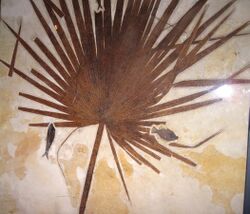Biology:Sabalites
From HandWiki
Short description: Extinct genus of palm
| Sabalites | |
|---|---|

| |
| Sabalites powelli palm frond and fossil fish in marlstone from the Eocene of Wyoming, US | |
| Scientific classification | |
| Kingdom: | Plantae |
| Clade: | Tracheophytes |
| Clade: | Angiosperms |
| Clade: | Monocots |
| Clade: | Commelinids |
| Order: | Arecales |
| Family: | Arecaceae |
| Genus: | †Sabalites Saporta 1865 |
Sabalites is an extinct genus of palm. Species belonging to the genus lived in the late Cretaceous to Miocene and have been found in South America,[1] North America, Europe, and Asia.[2][3] The genus is characterized by its costapalmate leaves,[4] which consist of a radial fan of leaves that have individual pronounced midribs (costa).
The genus was erected by Gaston de Saporta, who rejected Oswald Heer's previous placement of the relevant fossil species in the genus Sabal.[5]
Species
A number of species have been described in Sabalites.
References
- ↑ Berry, E. W. (1922). "The flora of the Concepcion-Arauco coal measures of Chile". The Johns Hopkins University Studies in Geology 4: 73–143.
- ↑ 2.0 2.1 "Sabalites Saporta 1865 (palm)". Macquarie University. 2007. http://www.fossilworks.org/cgi-bin/bridge.pl?taxon_no=54574&action=taxonInfo.
- ↑ Andrews, H. N. (1970). "Index of Generic Names of Fossil Plants, 1820-1965". Geological Survey Bulletin 1300. doi:10.3133/b1300. https://digital.library.unt.edu/ark:/67531/metadc1114957/.
- ↑ Matsunaga, Kelly K.S.; Smith, Selena Y. (March 2021). "Fossil palm reading: using fruits to reveal the deep roots of palm diversity". American Journal of Botany 108 (3): 472–494. doi:10.1002/ajb2.1616. PMID 33624301.
- ↑ "Études sur la végétation du sud-est de la France à l'époque tertiaire - Deuxième partie". Annales des sciences naturelles. Botanique. 5 3: 81. 1865. https://www.biodiversitylibrary.org/item/129998#page/85/mode/1up. "Nous réunissons, sous ce nom moins affirmatif que celui de Sabal adopté par M. Heer ...".
- ↑ MacGinitie, H. D. (1941). "A Middle Eocene Flora from the Central Sierra Nevada". Carnegie Institution of Washington Publication 534: 1–178.
- ↑ 7.0 7.1 Manchester, S. R. (2014). "Revisions to Roland Brown's North American Paleocene Flora". Acta Musei Nationalis Pragae 70 (3–4): 153–210. doi:10.14446/AMNP.2014.153. https://www.researchgate.net/publication/269995186. Retrieved 23 September 2021.
- ↑ Lozinsky, R.P. (1986). "Geologic and late Cenozoic history of the Elephant Butte area, Sierra County, New Mexico". New Mexico Bureau of Mines and Mineral Resources Circular 187. https://geoinfo.nmt.edu/publications/monographs/circulars/downloads/187/Circular-187.pdf. Retrieved 15 September 2020.
- ↑ Fritel, P.-H. (1910). "Étude sur les végétaux fossiles de l'étage Sparnacien du Bassin de Paris". Mémoires de la Société Géologique de France, Paléontologie 40: 1–37.
Wikidata ☰ Q108389804 entry
 |

